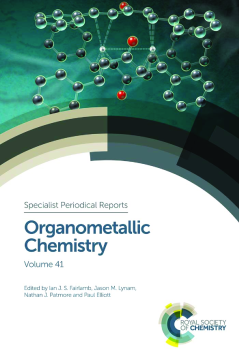
Additional Information
Book Details
Abstract
With the increase in volume, velocity and variety of information, researchers can find it difficult to keep up to date with the literature in their field. This interdisciplinary field has the potential to provide answers to problems and challenges faced in catalysis, synthetic organic chemistry and the development of therapeutic agents and new materials. Providing an invaluable volume, Organometallic Chemistry Volume 41 contains analysed, evaluated and distilled information on the latest in organometallic chemistry research including developments and applications of Lewis acidic boron reagents, masked low-coordinate main group species in synthesis and the diiron centre.
Table of Contents
| Section Title | Page | Action | Price |
|---|---|---|---|
| Cover | Cover | ||
| Preface | v | ||
| Contents | vii | ||
| Recent developments and applications of Lewis acidic boron reagents | 1 | ||
| 1 Introduction to Lewis acidic boron compounds | 1 | ||
| 2 Synthesis of Lewis acidic boron reagents | 3 | ||
| 3 Applications of novel boranes and borocations | 7 | ||
| 4 Advanced applications of Lewis acidic boron reagents | 12 | ||
| 5 Main group catalysis using boron reagents | 17 | ||
| 6 Conclusions | 23 | ||
| References | 24 | ||
| Masked low-coordinate main group species in synthesis | 28 | ||
| 1 Scope | 28 | ||
| 2 Notes | 28 | ||
| 3 Introduction | 29 | ||
| 4 Masking strategies | 30 | ||
| 5 A diversion: group 12 | 30 | ||
| 6 Low-coordinate monomers of group 13 elements | 31 | ||
| 7 Low-coordinate dimers of group 13 elements | 33 | ||
| 8 Low-coordinate monomers of group 14 elements | 33 | ||
| 9 Low-coordinate dimers of group 14 elements | 36 | ||
| 10 Low-coordinate monomers of group 15 elements | 37 | ||
| 11 Low-coordinate dimers of group 15 elements | 38 | ||
| 12 Low-coordinate main group heterodimers | 39 | ||
| 13 Conclusion | 41 | ||
| References | 42 | ||
| The diiron centre: Fe2(CO)9 and friends | 48 | ||
| 1 Introduction | 48 | ||
| 2 Fe2(CO)9: structure | 49 | ||
| 3 Fe2(CO)9: bonding and electron-counting | 51 | ||
| 4 Fe2(CO)9: in solution | 54 | ||
| 5 Unsaturated derivatives Fe2(CO)x [x=8-6] | 56 | ||
| 6 Isoelectronic derivatives [Fe2(CO)8]2- and [HFe2(CO)8]- | 58 | ||
| 7 Radical anions [Fe2(CO)x]- and cations [Fe2(CO)x] | 61 | ||
| 8 Derivatives of Fe2(CO)9 and [Fe2(CO)8]2-: general comments | 63 | ||
| 9 Replacement of bridging carbonyl(s): Fe2(CO)6(µ-CO)3-n(µ-X2)n | 63 | ||
| 10 Derivatives with bidentate ligands: Fe2(CO)6(µ-CO)(µ-L2) and Fe2(CO)5(ƙ2-L2)(µ-CO) | 68 | ||
| 11 Derivatives of [Fe2(CO)8]2-: Fe2(CO)8(ƙ1-X)2 and Fe2(CO)6(ƙ1-LX)2 | 71 | ||
| 12 Fe2(CO)6(µ-S2) and related chalcogenide complexes | 73 | ||
| 13 Diaazo-bridged complexes Fe2(CO)6(µ-RNNR) and phosphorus analogues | 76 | ||
| 14 Thionitroso Fe2(CO)6(µ-RNS) and alkyne Fe2(CO)6(µ-RCCR) complexes | 77 | ||
| 15 [Fe2(CO)6(µ-CO)(µ-LX)]- | 78 | ||
| 16 Fe2(ɳ4-C4R4)2(µ-CO)3 and related terminally substituted derivatives | 80 | ||
| 17 Concluding remarks | 81 | ||
| References | 81 | ||
| Taddol and Binol-derived chiral phosphonites in asymmetric catalysis | 93 | ||
| 1 Introduction | 93 | ||
| 2 Stereoelectronic profile of phosphonites | 94 | ||
| 3 Taddol-derived chiral phosphonites | 94 | ||
| 4 Binol-derived chiral phosphonites | 100 | ||
| 5 Conclusion | 107 | ||
| Acknowledgments | 107 | ||
| References | 108 | ||
| Gold-catalysed C–F bond activation | 110 | ||
| 1 Introduction | 110 | ||
| 2 Gold catalyses C–F bond activation | 111 | ||
| 3 Summary and outlook | 119 | ||
| Acknowledgments | 120 | ||
| References | 120 | ||
| Silylamides: towards a half-century of stabilising remarkable f-element chemistry | 123 | ||
| 1 Introduction and scope of the review | 123 | ||
| 2 Low coordination number complexes | 124 | ||
| 3 Reactivity | 134 | ||
| 4 Multiple bonds | 145 | ||
| 5 Conclusions | 147 | ||
| References | 148 |
